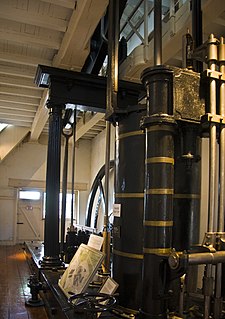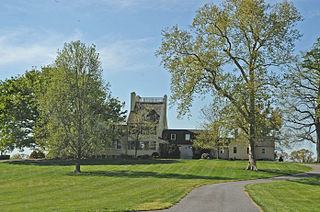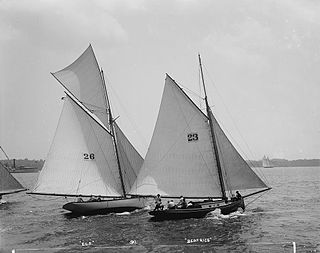
Chesapeake City is a town in Cecil County, Maryland, United States. The population was 673 at the 2010 census.

Locust Point is a peninsular neighborhood in Baltimore, Maryland. Located in South Baltimore, the neighborhood is entirely surrounded by the Locust Point Industrial Area; the traditional boundaries are Lawrence street to the west and the Patapsco River to the north, south, and east. It once served as a center of Baltimore's Polish-American, Irish-American and Italian-American communities; in more recent years Locust Point has seen gradual gentrification with the rehabilitation of Tide Point and Silo Point. The neighborhood is also noted as being the home of Fort McHenry and the western end of its namesake tunnel that carries eight lanes of Interstate 95 under the river.
West Nottingham Academy is an independent co-ed school serves both boarding and day students in grades 9-12. It was founded in 1744 by the Presbyterian preacher Samuel Finley, who later became President of The College of New Jersey. The 124-acre (0.50 km2), tree-lined campus is located in Colora, Cecil County, Maryland near the Chesapeake Bay – an hour and a half south of Philadelphia and twenty minutes north of Baltimore.

Ellicott City Historic District is a national historic district in Ellicott City, Howard County, Maryland. The Ellicott City Station is a National Historic Landmark located within the district. The district encompasses a predominantly 19th century mill town whose origins date to 1772, including more than 200 18th- and 19th-century buildings. It was listed on the National Register of Historic Places in 1978. The 2016 Maryland flood severely impacted the historic district on July 30, 2016, as did another flood on May 27, 2018.

The Old Lock Pump House on the Chesapeake & Delaware Canal was one of the first National Historic Landmarks to recognize an engineering achievement rather than an important building or a place associated with an historic event. The pump house, whose first element was built in 1837, preserves a feature of the old canal, which relied on locks and pumps to move vessels over the low divide of the Delmarva Peninsula between Chesapeake Bay and Delaware Bay. Because there are no large rivers on the peninsula, water had to be pumped uphill to fill the upper canal and locks. When the canal was cut deeper in the twentieth century, such measures were no longer required, and the pump house is one of the last relics of the old canal.

Cecil's Mill Historic District is a national historic district in Great Mills, St. Mary's County, Maryland. It consists of four buildings: Cecil's Mill, Cecil Store, the Cecil Home, and Old Holy Face Church. Cecil's Mill is a 2+1⁄2-story wood-framed structure, that was used until 1959. Across from the mill is the store, house, and Holy Face Church. The store was constructed in the 1920s and is a good example of a rural store. The Cecil Home was constructed in the late 19th century. Old Holy Face Church is a 2+1⁄2-story frame church that was abandoned in the 1940s.

The Inns on the National Road is a national historic district near Cumberland, Allegany County, Maryland. It originally consisted of 11 Maryland inns on the National Road and located in Allegany and Garrett counties. Those that remain stand as the physical remains of the almost-legendary hospitality offered on this well-traveled route to the west.

Mount Harmon is an historic home, located at Earleville, Cecil County, Maryland, United States. It was listed on the National Register of Historic Places in 1974, and is currently open to the public.

The Thomas Richards House is a historic home located at Rising Sun, Cecil County, Maryland, United States. It is a stone and brick farmhouse; the 1+1⁄2-story kitchen section of fieldstone construction dating from the late 18th century, and the main block of brick construction, dating from the early 19th century. Also on the property is a large stone and wood three-level bank barn.

Rose Hill, also known as Chance and Wheeler Point, is a historic home located at Earleville, Cecil County, Maryland, United States. It is the product of four major building periods: a gambrel-roofed frame structure built at the end of the 18th or beginning of the 19th century; a 2+1⁄2-story brick "town house" constructed on the east in 1837; and a small frame kitchen and a one-story wing built in the 1960s. Also on the property are a smokehouse, ice house, and shed. The garden includes two of the largest yew trees living in the United States. It was the home of General Thomas Marsh Forman (1756–1845), who served as a young man in the American Revolutionary War.

Woodlands is a historic home located at Perryville, Cecil County, Maryland, United States. It appears to have been constructed in two principal periods: the original 2+1⁄2-story section built between 1810 and 1820 of stuccoed stone and a 1+1⁄2-story rear kitchen wing; and two bays of stuccoed brick, with double parlors on the first story, and a one-story, glazed conservatory constructed between 1840 and 1850. The home features Greek Revival details. Also on the property are a 2-story stone smokehouse and tenant house, a small frame barn and corn house, a square frame privy with pyramidal roof, a carriage house, frame garage, and a large frame bank barn.
The Grear Prehistoric Village Site is an archeological site located near Crystal Beach, Cecil County, Maryland. The site was discovered and tested by an amateur archeologist in 1971. It is the northernmost known Late Woodland period village site on the Eastern Shore of the Chesapeake Bay outside of the Susquehanna River Basin.

Indian Queen Tavern and Black's Store is a historic hotel and store complex located at Charlestown, Cecil County, Maryland, USA. It consists of two mid-18th century structures: Black's Store, originally the Red Lyon Inn, and the Indian Queen Tavern, later called Hotel. The two taverns and their remaining outbuildings form a court. The outbuildings include a log kitchen with a loft and a two-story smokehouse.

Elf is a racing yacht built in 1888 by George Lawley & Son of South Boston, Massachusetts, for William H. Wilkinson. She was designed by George F. Lawley and is the oldest small yacht in the United States. She is located at the Chesapeake Bay Maritime Museum in St. Michaels, MD.Talbot County, Maryland.

Knoxville is an unincorporated community in Frederick and Washington counties, Maryland, United States. The Robert Clagett Farm and Magnolia Plantation are listed on the National Register of Historic Places.

Jeremiah Brown House and Mill Site is a Colonial-era mill complex and national historic district at Rising Sun, Cecil County, Maryland, United States. It consists of two distinct halves: a two-story, three-bay, gable-roofed stone structure built in 1757 by Jeremiah Brown, Sr., a Quaker from Pennsylvania; and a two-story, two-bay gable-roofed frame house built in 1904 by John Clayton on the site of the original 1702 log wing. Also on the property is a small 19th century bank barn; a reconstruction of the original mill built on top of the stone foundations of the 1734 Brown Water Corn and Gristmill; and the foundations of an 18th-century saw mill.
Charlestown Historic District is a national historic district at Charlestown, Cecil County, Maryland, United States. It consists of a 150-acre (0.61 km2) portion of the town containing all known existing 18th century features. There are 14 houses known to have been constructed during that century and its largest structures were the inns and hotels which served the popular Charlestown Fair in the colonial period.

Manokin Historic District is a national historic district at Princess Anne, Somerset County, Maryland, United States, located at the mouth of the Manokin River. It consists of the Manokin settlement, which forms a unique and visually interesting area of great historical significance on the Lower Eastern Shore. These structures, Clifton, More and Case It, Almodington, Elmwood, and Homewood are most strongly linked together visually, culturally, and historically. Architecturally the buildings span the period between the early 18th and the mid 20th centuries.

Williamsport Historic District is a national historic district at Williamsport, Washington County, Maryland, United States. The district consists of the historic core of this town. Almost 20 percent of the buildings in the district date from the late 18th and early 19th centuries. They are generally of log or brick construction until the second quarter of the 19th century. The town grew with the Chesapeake and Ohio Canal and railroads, which resulted in prominent late 19th century Italianate and Queen Anne style buildings for residential and commercial purposes. Slightly less than 60 percent of the buildings date from the late 19th and early 20th centuries.

South Prospect Street Historic District is a national historic district at Hagerstown, Washington County, Maryland, United States. The district is a 19th and early 20th century residential neighborhood which was once the address of many of Hagerstown's leading citizens. The street is lined with more than 50 structures representing America's varied and strong architectural heritage and includes both domestic and ecclesiastical buildings, such as Saint John's Church and the Presbyterian Church. The architectural styles represented range from the Neoclassical of the early 19th century to the classical revivals of the early 20th century.





















